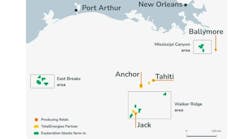Satellite-based communications services are available to the offshore industry from SatPoint as part of its range of GSM - global system for mobile communications - services for marine users.
SatPoint took an important step toward realizing its ambition to achieve cellular connectivity at sea last December when it became the first Swedish company to be awarded a spectrum license in the 1800 MHz band for cellular services on board ships in Swedish territorial waters. The Swedish Post and Telecom Agency, PTS awarded the license, which allows the company to provide a local GSM network on a ship or rig. The company is now applying for spectrum licenses in other territorial waters in which it operates.
In-house development
With a service that embraces GSM connectivity, whether wired or by satellite, broadband connectivity over satellite and full VoIP (voice-over internet protocol) telephone, SatPoint can provide different levels of offshore-to-shore communications in accordance with an offshore operator’s requirements, says President and CEO Mike Reichel. These can vary from voice-only to a comprehensive service including data transmission. Offshore personnel can use their mobile phones to communicate on the rig or to shore, and all corporate telecommunications needs can be provided.
SatPoint’s policy is to develop its own equipment solutions when it finds existing products inadequate. Its major contribution is the SatMax V fully integrated VSAT - very small aperture terminal - stabilized antenna system. This is available in three sizes of reflector - 1.3 m, 1.8 m, and 2.4 m - for high-frequency Ku, Ka, and C band applications in 4 W, 8 W, and 16 W versions.
The development was undertaken because in the company’s view antenna systems developed for onshore use do not provide a satisfactory basis for a marine system, while the gimball-based systems employing gyros and accelerometers, which are widely used at sea, are costly and technically inadequate.
Cassegrain design principle
SatMax has a pointing accuracy from antenna to satellite of better than 0.25˚. The reflector, which is designed on the Cassegrain principle, can cope with difficulties of the marine environment such as heavy pitch and roll, which cause reflectors adapted from land applications to fail. Its carbon fiber construction gives it good immunity to the severe vibrations often encountered on a marine vessel.
The reflector is supported by an elevation frame, which holds the polarization subframe housing the entire radio frequency package. The elevation frame is held by the azimuth frame, cast as a single piece aluminum alloy structure which is strong enough to withstand several times the forces it will likely be exposed to. Inside the azimuth frame is the drive unit, a lifetime-rated brushless DC motor that provides peak torque when most needed, at low speeds. Incremental resolution is one hundredth of a degree. The whole structure is supported on a non-rotating steel fundament.
The SatMax system is easy to install, with mechanical and electrical interfaces to the ship or rig kept to a minimum. A novel diplexer design has been developed, which packs transmit, receive, reference, and Ethernet signals over one coaxial cable. The combination of cast aluminum and carbon fiber makes it rugged but of low weight - for example, a 1.3 m antenna system weighs about 130 kg, around half that of most competing equivalent systems, according to Reichel. With its low mechanical complexity, a minimum of service is required, resulting in maximum uptime.
In addition to supplying the necessary hardware and a satellite connection, the company provides around-the-clock monitoring and control of the service to ensure constant availability, plus financing where required by the customer.
One of its partners is Nordic Satellite, whose satellite network SatPoint uses as part of its multi-service platform for data and telecommunications in the maritime business sector. It is also Nordic Satellite’s designated service provider for the maritime sector.
The company uses the internet protocol (IP) for land-sea-land communications, including voice-over IP for phone conversations. This allows the rig or offshore installation to become part of the customer’s local area network rather than its PBX telephone system, which in turns means that the spare capacity not used for conversation, which takes priority, can be given over to data transmission. Communications use is charged at a flat rate, so the customer has good control over the cost being incurred.•
For more information, contact Mike Reichel, SatPoint. Tel +46 8541 315 00, fax +46 8765 22 56, [email protected], www.satpoint.se.




